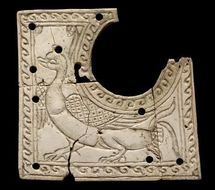
Agatha Christie ivories
Preferring to undertake a less physical role, Christie said she used "an orange stick, possibly a very fine knitting needle... and a jar of cosmetic face cream... for gently coaxing the dirt out of the crevices without harming the friable ivory."
While at the site, Christie stayed in a room separate from the workers' tents where she penned several novels including "Hickory Dickory Dock."
The museum paid 1.17 million pounds (1.89 million dollars, 1,36 million euros) for the 3,000-year-old objects, which were uncovered by Mallowan between 1949 and 1963 in what is now northern Iraq.
The items, carved from African elephant tusks, include a lion's paw and a lifesize human ear.
The city was built in the 13th century BC by Assyrian king Shalmaneser I before becoming the capital of the Assyrian Empire five hundred years later.
The empire encompassed modern-day Iraq, Lebanon, Syria, Kuwait and Jordan, and around half of Saudi Arabia, Egypt and Iran.
Neil MacGregor, the museum's director said: "Not only are they beautiful but they clearly carry in them a whole set of stories."
Some of the 6,000 pieces will go on display at the museum from next week.
--------------------------------------------------------------------------------
While at the site, Christie stayed in a room separate from the workers' tents where she penned several novels including "Hickory Dickory Dock."
The museum paid 1.17 million pounds (1.89 million dollars, 1,36 million euros) for the 3,000-year-old objects, which were uncovered by Mallowan between 1949 and 1963 in what is now northern Iraq.
The items, carved from African elephant tusks, include a lion's paw and a lifesize human ear.
The city was built in the 13th century BC by Assyrian king Shalmaneser I before becoming the capital of the Assyrian Empire five hundred years later.
The empire encompassed modern-day Iraq, Lebanon, Syria, Kuwait and Jordan, and around half of Saudi Arabia, Egypt and Iran.
Neil MacGregor, the museum's director said: "Not only are they beautiful but they clearly carry in them a whole set of stories."
Some of the 6,000 pieces will go on display at the museum from next week.
--------------------------------------------------------------------------------









 Home
Home Politics
Politics









